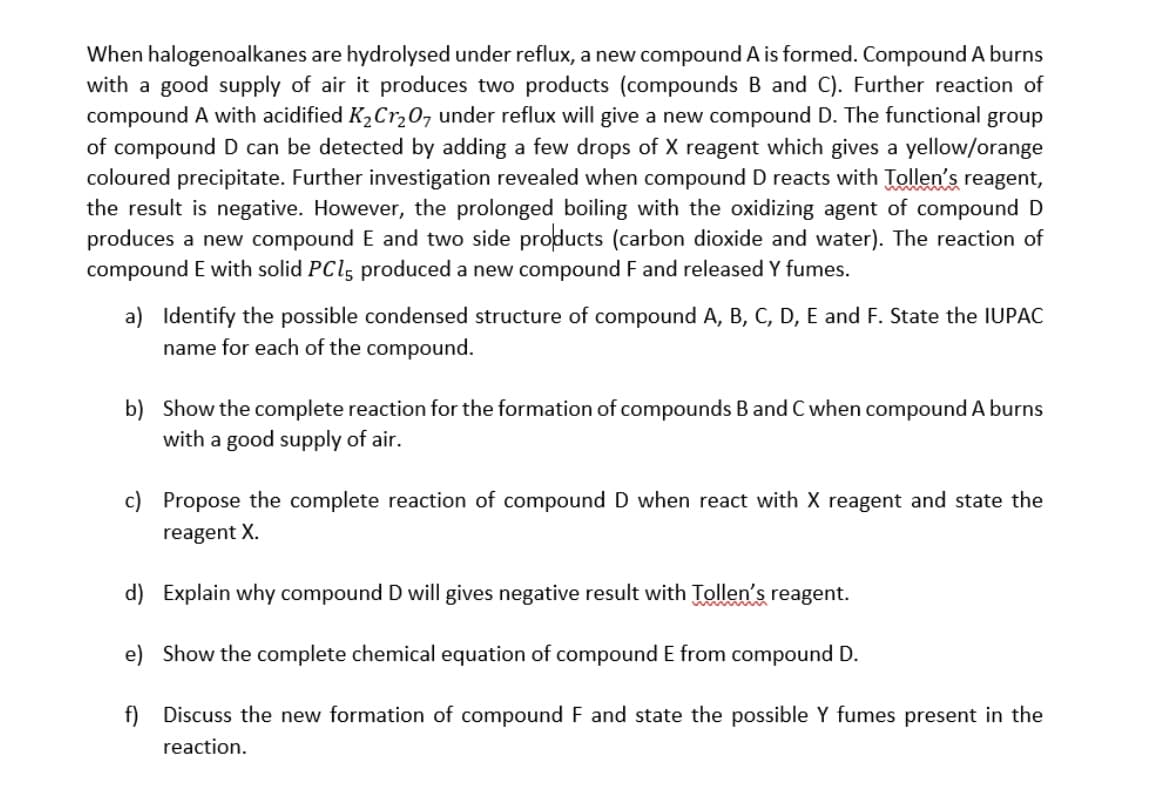When halogenoalkanes are hydrolysed under reflux, a new compound A is formed. Compound A burns with a good supply of air it produces two products (compounds B and C). Further reaction of compound A with acidified K2Cr207 under reflux will give a new compound D. The functional group of compound D can be detected by adding a few drops of X reagent which gives a yellow/orange coloured precipitate. Further investigation revealed when compound D reacts with Tollen's reagent, the result is negative. However, the prolonged boiling with the oxidizing agent of compound D produces a new compound E and two side products (carbon dioxide and water). The reaction of compound E with solid PCl, produced a new compound F and released Y fumes. a) Identify the possible condensed structure of compound A, B, C, D, E and F. State the IUPAC name for each of the compound. b) Show the complete reaction for the formation of compounds B and C when compound A burns with a good supply of air. c) Propose the complete reaction of compound D when react with X reagent and state the reagent X. d) Explain why compound D will gives negative result with Tollen's reagent. e) Show the complete chemical equation of compound E from compound D.
When halogenoalkanes are hydrolysed under reflux, a new compound A is formed. Compound A burns with a good supply of air it produces two products (compounds B and C). Further reaction of compound A with acidified K2Cr207 under reflux will give a new compound D. The functional group of compound D can be detected by adding a few drops of X reagent which gives a yellow/orange coloured precipitate. Further investigation revealed when compound D reacts with Tollen's reagent, the result is negative. However, the prolonged boiling with the oxidizing agent of compound D produces a new compound E and two side products (carbon dioxide and water). The reaction of compound E with solid PCl, produced a new compound F and released Y fumes. a) Identify the possible condensed structure of compound A, B, C, D, E and F. State the IUPAC name for each of the compound. b) Show the complete reaction for the formation of compounds B and C when compound A burns with a good supply of air. c) Propose the complete reaction of compound D when react with X reagent and state the reagent X. d) Explain why compound D will gives negative result with Tollen's reagent. e) Show the complete chemical equation of compound E from compound D.
Chemistry
10th Edition
ISBN:9781305957404
Author:Steven S. Zumdahl, Susan A. Zumdahl, Donald J. DeCoste
Publisher:Steven S. Zumdahl, Susan A. Zumdahl, Donald J. DeCoste
Chapter1: Chemical Foundations
Section: Chapter Questions
Problem 1RQ: Define and explain the differences between the following terms. a. law and theory b. theory and...
Related questions
Question

Transcribed Image Text:When halogenoalkanes are hydrolysed under reflux, a new compound A is formed. Compound A burns
with a good supply of air it produces two products (compounds B and C). Further reaction of
compound A with acidified K2Cr20, under reflux will give a new compound D. The functional group
of compound D can be detected by adding a few drops of X reagent which gives a yellow/orange
coloured precipitate. Further investigation revealed when compound D reacts with Tollen's reagent,
the result is negative. However, the prolonged boiling with the oxidizing agent of compound D
produces a new compound E and two side products (carbon dioxide and water). The reaction of
compound E with solid PCl, produced a new compound F and released Y fumes.
a) Identify the possible condensed structure of compound A, B, C, D, E and
name for each of the compound.
State the IUPAC
b) Show the complete reaction for the formation of compounds B and C when compound A burns
with a good supply of air.
c) Propose the complete reaction of compound D when react with X reagent and state the
reagent X.
d) Explain why compound D will gives negative result with Tollen's reagent.
e) Show the complete chemical equation of compound E from compound D.
f) Discuss the new formation of compound F and state the possible Y fumes present in the
reaction.
Expert Solution
This question has been solved!
Explore an expertly crafted, step-by-step solution for a thorough understanding of key concepts.
Step by step
Solved in 2 steps with 2 images

Knowledge Booster
Learn more about
Need a deep-dive on the concept behind this application? Look no further. Learn more about this topic, chemistry and related others by exploring similar questions and additional content below.Recommended textbooks for you

Chemistry
Chemistry
ISBN:
9781305957404
Author:
Steven S. Zumdahl, Susan A. Zumdahl, Donald J. DeCoste
Publisher:
Cengage Learning

Chemistry
Chemistry
ISBN:
9781259911156
Author:
Raymond Chang Dr., Jason Overby Professor
Publisher:
McGraw-Hill Education

Principles of Instrumental Analysis
Chemistry
ISBN:
9781305577213
Author:
Douglas A. Skoog, F. James Holler, Stanley R. Crouch
Publisher:
Cengage Learning

Chemistry
Chemistry
ISBN:
9781305957404
Author:
Steven S. Zumdahl, Susan A. Zumdahl, Donald J. DeCoste
Publisher:
Cengage Learning

Chemistry
Chemistry
ISBN:
9781259911156
Author:
Raymond Chang Dr., Jason Overby Professor
Publisher:
McGraw-Hill Education

Principles of Instrumental Analysis
Chemistry
ISBN:
9781305577213
Author:
Douglas A. Skoog, F. James Holler, Stanley R. Crouch
Publisher:
Cengage Learning

Organic Chemistry
Chemistry
ISBN:
9780078021558
Author:
Janice Gorzynski Smith Dr.
Publisher:
McGraw-Hill Education

Chemistry: Principles and Reactions
Chemistry
ISBN:
9781305079373
Author:
William L. Masterton, Cecile N. Hurley
Publisher:
Cengage Learning

Elementary Principles of Chemical Processes, Bind…
Chemistry
ISBN:
9781118431221
Author:
Richard M. Felder, Ronald W. Rousseau, Lisa G. Bullard
Publisher:
WILEY